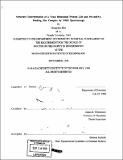| dc.contributor.advisor | James R. Williamson. | en_US |
| dc.contributor.author | Mao, Hongyuan, 1969- | en_US |
| dc.date.accessioned | 2009-11-06T16:17:55Z | |
| dc.date.available | 2009-11-06T16:17:55Z | |
| dc.date.copyright | 1998 | en_US |
| dc.date.issued | 1998 | en_US |
| dc.identifier.uri | http://hdl.handle.net/1721.1/49674 | |
| dc.description | Thesis (Ph.D.)--Massachusetts Institute of Technology, Dept. of Chemistry, 1998. | en_US |
| dc.description | Includes bibliographical references (p. 342-353). | en_US |
| dc.description.abstract | The yeast (Saccharomyces cerevisiae) ribosomal protein L30 and its auto-regulatory pre-mRNA binding site provide one of the best examples the critical role of protein-RNA interactions in regulation of RNA processing and control of gene translation. A model system for this interaction, which includes the ribosomal L30 protein and the phylogenetically conserved RNA segment for auto-regulation, was studied using nuclear magnetic resonance (NMR) spectroscopy. The L30 protein recognizes and binds tightly to the stem-internal loop-stem RNA, the recognition elements of which lie mostly on the conserved two-plus-five asymmetric purine-rich internal loop. NMR characterizations were carried out on both the free and bound forms of the protein and the RNA. Detailed analyses of the protein revealed that the main architecture, a fourstranded n-sheet sandwiched between four a-helices, is present both in the free and in the bound form. There are however, substantial local perturbations that accompany RNA binding, the largest of which have been mapped onto the loops connecting Strand A and Helix 2, Strand B and Helix 3, Helix 4 and Strand D. In contrast to the protein, the internal loop of the RNA undergoes significant changes upon complex formation, and the most distinct observation was the formation of the G 11G56 reverse Hoogsteen mismatch pair. Structure modeling using simulated annealing in restrained molecular dynamics was carried out in X-PLOR. Detailed analyses of the complex structure reveal that the protein recognizes the RNA mostly along one side of the internal loop with five purines. The interactions are divided further into two sections. One region consists of mostly aromatic stacking and hydrophobic contacts from Leu25, Phe85 and Val87 of the protein to G56 of the RNA. The other region consists of mostly specific contacts, which include recognition of A57 by Asn 48, and G58 by Arg 52. The L30 protein- RNA complex structure thus determined using NMR spectroscopy not only provides a detailed insight for understanding the structure-function relationship regarding the yeast auto-regulation, it also further demonstrates the important role of the protein-RNA interaction in controlling RNA processing and gene translation. | en_US |
| dc.description.statementofresponsibility | by Hongyuan Mao. | en_US |
| dc.format.extent | 355 p. | en_US |
| dc.language.iso | eng | en_US |
| dc.publisher | Massachusetts Institute of Technology | en_US |
| dc.rights | M.I.T. theses are protected by
copyright. They may be viewed from this source for any purpose, but
reproduction or distribution in any format is prohibited without written
permission. See provided URL for inquiries about permission. | en_US |
| dc.rights.uri | http://dspace.mit.edu/handle/1721.1/7582 | en_US |
| dc.subject | Chemistry | en_US |
| dc.title | Structure determination of a yeast ribosomal protein L30 and pre-mRNA binding site complex by NMR spectroscopy | en_US |
| dc.type | Thesis | en_US |
| dc.description.degree | Ph.D. | en_US |
| dc.contributor.department | Massachusetts Institute of Technology. Department of Chemistry | en_US |
| dc.identifier.oclc | 42363586 | en_US |
